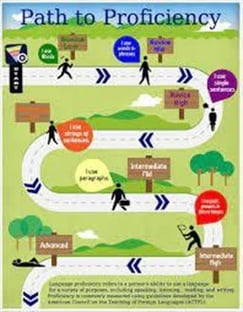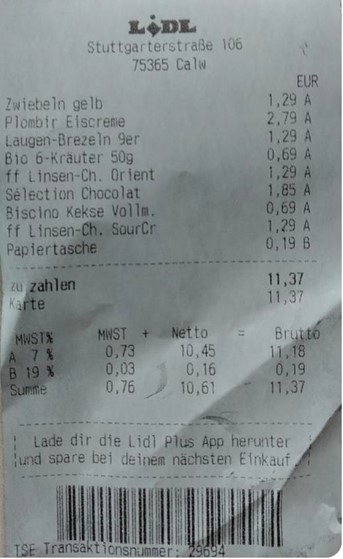In the following article, Melanie Mello, language teacher and ACTFL Teacher of the Year finalist, discusses how authentic cultural materials that reflect a language learner’s real-life experience -- such as texts, receipts, newspaper articles and social media posts -- help develop the intercultural competence and skills necessary to communicate successfully. While traditional textbooks rely heavily on vocabulary lists and grammar exercises, XanEdu’s custom curriculum materials save schools and districts time and money by securing specific, often hard-to-find, culturally relevant resources and compiling them in digital and print form.
Growing up in Germany in the ‘90s meant that I had the opportunity, like most fifth graders there, to study English in school. My personal English language learning journey began at the Realschule (a comprehensive secondary school leading to vocational training after graduating in tenth grade). However, when my mother realized that I was not challenged enough at this level, at the beginning of seventh grade I was enrolled at the Gymnasium (a college preparatory school, after which you attend university). For me, this was a year of many sorrows and joys: sorrows because I missed my former classmates and because it was difficult keeping up with the rigor of my core classes; joys, because I was able to participate in my first student exchange, visiting England for two weeks. It was during that exchange visit that I first discovered my love for the English language, leading to my decision to study English Literature when I attended university.
I showed up for my first classes at the university confident I would excel, both in my studies and as a secondary school teacher for English and German. Throughout my first couple of weeks in college, I was able to keep up with the in-class requirements, but I quickly realized my limitations with the English language; particularly, when I met my future husband, an American exchange student from California. My English classes up to this point were geared toward translation exercises, reading comprehension activities, memorizing vocabulary and grammatical concepts, and completing one exercise after another out of the textbook -- exercises and activities that clearly did not prepare me sufficiently enough to be successful in college or in many real-life situations.
Following the advice of a German saying “Liebe geht durch den Magen” --Love goes through the stomach--I thought it would be a great idea to suggest to my then boyfriend that we should prepare a typical German meal together in the kitchen of his student dorm. At the supermarket, it became apparent to me how limited my vocabulary was – I was constantly searching for the correct translation of the ingredients we needed to cook the Swabian-style lentils. Being at the store gave me the advantage of being able to point at the ingredient to ask for the English translation, but it was a different story altogether while we were cooking. It felt more like playing charades or Catch Phrase than cooking:
“Do you have a Sieb?” “A what?”
“The metal thing that you pour the spaghetti into after you boiled them to separate noodles from the water.”
I felt like one of those people you meet who tell you that they took several years of a world language in school but can’t remember anything they learned. At that moment, I promised myself that if I ever was lucky enough to teach a world language class that I would make certain my students wouldn’t suffer the same fate, and that I would provide them with as much real-life application as possible.
When I was first hired as a teacher, I was determined to enrich the curriculum with authentic materials to ensure that my students would be confident enough in the target language to handle most everyday situations successfully. When talking about authentic materials, we speak of texts, visuals, audio recordings, and videos created by and for native speakers for pleasure or to convey information and NOT about materials that have been designed for language learning purposes. For example, in our daily lives we encounter the following printed materials:
| time schedules | greeting cards | applications | (street) signs | literature (graphic novels, poems, etc.) |
| catalogues | infographics | reviews | social media posts | magazine/newspaper articles |
and the following auditory materials:
| interviews | voice messages | radio broadcasts | podcasts |
| audio books | TV shows | movies | songs/song lyrics |
But how does one select authentic resources that are appropriate for the learner? First, you need to check to make sure that the material you chose is accessible to your students by checking off the following boxes:
1. Is the material appropriate for the students’ age level?
2. Is the material appropriate for the students’ performance level: Novice - Intermediate - Advanced - Superior (low - mid - high)?
3. Is the content connected to the students’ prior and/or background knowledge?
4. Is the content supported by text features, such as pictures, diagrams, headings, index, etc.?
Next, you want to select material that is appealing to your students. For this purpose, think about the materials that you have used in class before that seemed to be popular with the students, and that led to the learning outcomes that you intended. Also, consider asking the following questions when deciding if the material are right for your students:
1. Is the content relevant to the needs and characteristics of your students?
2. Will the selected material catch your students’ attention?
3. Is the content current?
When in doubt, don’t be afraid to ask your students to offer their own examples of materials they would like to work with in the classroom. This engages your students in their own learning and can lead to exciting discoveries that forever change your approach to teaching that lesson.
Lastly, the authentic materials you choose should be aligned with your students’ learning goals and the American Council on the Teaching of Foreign Languages Proficiency Guidelines to ensure that your students are on the path of language proficiency. I recommend finding authentic sources that allow you to design appropriate tasks that encourage your students to practice their interpretive, interpersonal, and presentation skills.
You might argue that I am a lunatic to suggest using authentic materials with your first-year students, as you might feel that these materials are too difficult for your students to handle. Keep in mind, however, that you can always adapt the task to the text. For instance, if you selected a full-length article for your students that is too advanced for their current level, you could ask them to read the headlines only and to describe the pictures before asking them what they think the article is about. Next school year, when the students are further along in their studies, you could re-visit the article and focus your discussion on its content. Another option would be to choose a text type and language style that is appropriate for your beginner learner, such as reading a class schedule, Instagram post, or an infographic. Since many teachers seem to struggle to find authentic materials that they find appropriate for the novice level, I would like to give you an example from my own teaching practice. My German 1 students are currently working on their “Food Shopping” unit for which I designed an “interpretive task comprehension” using a supermarket receipt (see picture). This exercise follows the structure of an Integrated Performance Assessment, where students have to interpret the receipt by answering the following questions in German:
I. Key word recognition. Find the German word/phrase (chronological) that best expresses the meaning of each of the following English words/phrases:
1. yellow onions =
2. lentils =
3. milk chocolate cookies =
4. paper bag =
5. sum =
6. to download =
II. Main Idea. Using information from the text, provide the main idea of the article in English.
1. What do you think? For what reason did the person go shopping?
III. Guessing Meaning From Context. Based on this text, write what the following three words/phrases probably mean in English:
1. What does “zu zahlen” mean?
2. What does “Brutto” mean?
3. What does “sparen” mean?
IV. Inferences. “Read between the lines” to answer the following questions, using information from the receipt. Your response may be in English or German.
1. For how many people did the person go shopping? Why do you think that?
2. What is the person cooking for lunch?
3. What is going to be served for dessert?
V. Comparing Cultural Perspectives.
Think about your last shopping trip to the supermarket. How do you bag your groceries compared to the German shopper who had to purchase a paper bag for 0.19 €?
As you see, using authentic materials not only exposes the student to the target language as it is used in real-life situations, but also brings the target culture to life by creating opportunities to highlight cultural similarities and differences between the students’ own culture and the culture studied.
All learners benefit greatly from having to learn to negotiate authentic materials. Just as I stretched my language abilities to cook with someone in a real-world situation, students stretch their language abilities when they engage with authentic materials in ways that deepen their engagement, improve outcomes, and, often, lighten the mood. The trick is in finding the right materials that check all the boxes listed above. Just as I would not give first year students work from Johann Wolfgang von Goethe, I would not waste the time of my advanced students with a shopping receipt. Authentic materials must be chosen with care and bespoke to the context within which they are delivered. If a teacher is mindful of the materials they offer, the teacher can build a classroom environment that is challenging, joyful, and productive.
Click here to learn more about how XanEdu worked with Pinellas County Schools (PCS) to provide highly-customized, culturally relevant foreign language materials when the district transitioned to a new World Languages program. XanEdu’s team of experts managed the entire customized curriculum process, providing PCS with a World Languages curriculum that met their needs, was cost effective, allowed teachers to focus more on teaching, and aligned to new teaching strategies.